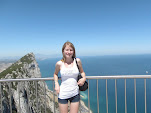I have been in Santa Cruz de la Sierra, Bolivia, for about a month now.


Above: Giant cactus'!
My Spanish is definitely getting better! However, my host mom still introduces me as her daughter that SPEAKS Spanish, but doesn't UNDERSTAND Spanish. This is because the people here talk really fast, and my ears are still adjusting so that I can tell the difference between the start and end of words. I am getting better at it though!
My first weekend here, my family drove to Samaipata. Samaipata is about 75 miles outside of the city. It is a small pueblo famous for El Fuerte, a giant rock that they believe was carved by the Incans. My family shares a house there with three other families, so we all went and had a blast.

Above: On the way to Samaipata.. the beautiful Bolivian countryside.
On normal weekends, everyone usually has their own agendas on Fridays and Saturdays. Then on Sundays we go to la quinta (our little farm) where we rest in hammocks, cook barbeque, and see my grandparents. There is also a pool there, but since it is "winter," it's not filled up yet. There are star fruit trees there, too, and it's awesome to be able to go pick and eat star fruit straight from the tree.

Above: La quinta.
I really like my school here. All the kids in my culso (class) are really good friends with each other. In late November/early December we are going to take a promo (senior) trip to Camboriu and Foz de Iguazu in Brazil! It's a two-week trip, and I couldn't be more excited!

Above: Giant cactus'!
My Spanish is definitely getting better! However, my host mom still introduces me as her daughter that SPEAKS Spanish, but doesn't UNDERSTAND Spanish. This is because the people here talk really fast, and my ears are still adjusting so that I can tell the difference between the start and end of words. I am getting better at it though!
My first weekend here, my family drove to Samaipata. Samaipata is about 75 miles outside of the city. It is a small pueblo famous for El Fuerte, a giant rock that they believe was carved by the Incans. My family shares a house there with three other families, so we all went and had a blast.

Above: On the way to Samaipata.. the beautiful Bolivian countryside.
On normal weekends, everyone usually has their own agendas on Fridays and Saturdays. Then on Sundays we go to la quinta (our little farm) where we rest in hammocks, cook barbeque, and see my grandparents. There is also a pool there, but since it is "winter," it's not filled up yet. There are star fruit trees there, too, and it's awesome to be able to go pick and eat star fruit straight from the tree.

Above: La quinta.

Above: A common sight: people selling goods along the street.
My school dress code is a school t-shirt and jeans or denim shorts that come past your knees. Several of the other schools have uniforms of short skirts and blouses, but not mine.
Outside of my school, I am also taking lessons in Spanish and in Salsa! The Spanish lessons are provided by Rotary, and the Salsa classes are with a friend of the family. I have both classes 3 times a week, so I stay pretty busy.
Everything here is really cheap. 7 bolivianos is about US$1. It's crazy to spend so many "100" bills here, but 100bs = US$14, which isn't much. Yet people still have trouble breaking their 100 bills, because a $14 bill is just too big!

Above: Hippies in Samaipata selling their goods. You can also see a pay phone in this picture. All the pay phones in Bolivia are disguised as different giant birds.
Thinking of money, I haven't really bought much yet except for earrings. There are lots of "hippies" that can be found in the centers of the cities here, and they sell the most beautiful, cheap, handmade jewelry. I have one pair made of peacock feathers and vegetable ivory, which is from the nut of the tagua palm tree and has the same properties and looks as elephant tusk ivory.
One of the craziest things I have encountered here so far was at a college fair at the Universidad Católica Boliviana. They had a section of the university set up for teaching us about their medical program, and to illustrate the kind of work they do, they had about 6 dead bodies lying out on tables. The flesh of the bodies had been ripped aside so we could view the tendons and such. Then, they gave us each a glove and had us feel the insides of the cadavers and told us about each organ as we felt it. I'm pretty sure this would violate some health codes in the States!

Above: A cadaver whose insides I got to feel.
As you probably know, the political situation in Bolivia has been unstable for the past week or so. Santa Cruz has been trying for a long time to gain ¡Autonomía! (autonomy), and for the first time, the protests turned violent with tear gas, fireworks, fires in the streets, and road blocks. I have had a lot of canceled school because of this, and there was one day when my family had me stay inside all day, just to be safe.

Above: Every city in Bolivia that supports the Autonomía has an Autonomía pole in the center of their town.
Well, that's all I have to say right now!
Chao, chao!
Maija


